Schumacher INC-14825A User Manual
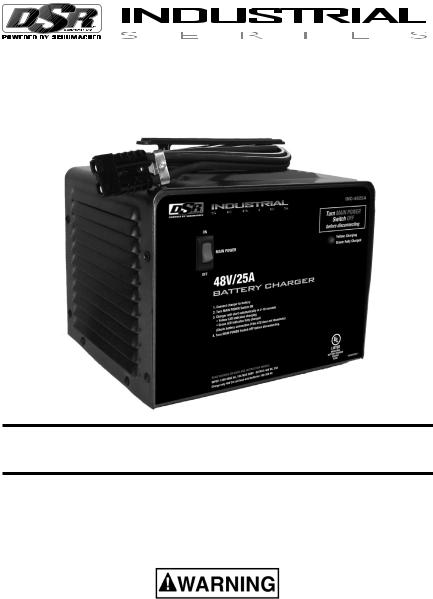
Model / Modelo / Modèle: INC-4825A
Automatic Battery Charger / Cargador de batería automático / Chargeur de batterie automatique
Voltage / Tensión / Tension: 48
Amperage / Amperaje / Ampérage: 15<>25 Cycling
•OWNER’S MANUAL
•Manual del usuario
•GUIDE D’UTILISATION
•READ THE ENTIRE MANUAL BEFORE USING THIS PRODUCT. FAILURE TO DO SO CAN RESULT IN SERIOUS INJURY OR DEATH.
•LEA EL MANUAL COMPLETO ANTES DE UTILIZAR ESTE PRODUCTO. CUALQUIER FALLA PODRÍA RESULTAR EN SERIAS LESIONES O PODRÍA SER MORTAL.
•LIRE ENTIÈREMENT LE GUIDE AVANTD’UTILISER CE PRODUIT. L’ÉCHEC DE FAIRE AINSI PEUT S’ENSUIVRE DANS LA BLESSURE SÉRIEUSE OU LA MORT.
00-99-000992/0909

Table of Contents
Section |
Page |
IMPORTANT SAFETY INSTRUCTIONS |
2 |
PERSONAL PRECAUTIONS |
3 |
PREPARING TO CHARGE |
3 |
CHARGER LOCATION |
4 |
DC CONNECTION PRECAUTIONS |
4 |
FOLLOW THESE precautions WHEN connecting the BATTERY. |
5 |
BATTERY CHARGING – AC CONNECTIONS |
5 |
FEATURES |
6 |
OPERATING INSTRUCTIONS |
6 |
CALCULATING CHARGE TIME |
8 |
MAINTENANCE INSTRUCTIONS |
9 |
STORAGE INSTRUCTIONS |
9 |
TROUBLESHOOTING |
9 |
BEFORE RETURNING FOR REPAIRS |
10 |
SPECIFICATIONS |
10 |
LIMITED WARRANTY |
11 |
ÍNDICE
SECCIÓN |
PÀGINA |
INSTRUCCIONES IMPORTANTES DE SEGURIDAD |
13 |
PRECAUCIONES PERSONALES |
14 |
PREPARACIÓN PARA LA CARGA |
14 |
UBICACIÓN DEL CARGADOR |
15 |
PRECAUCIONES DE CONEXIÓN EN CC |
16 |
SIGA ESTAS INDICACIONES CUANDO CONECTE LA BATERIA. |
16 |
CARGA DE BATERÍA, CONEXIONES DE CA |
16 |
CARACTERÍSTICAS |
17 |
INSTRUCCIONES DE OPERACIÓN |
17 |
CÁLCULO DE TIEMPO DE CARGA |
19 |

INSTRUCCIONES DE MANTENIMIENTO |
20 |
INSTRUCCIONES DE ALMACENAJE |
20 |
LOCALIZACIÓN Y SOLUCIÓN DE PROBLEMAS |
21 |
ANTES DE DEVOLVER A REPARACIONES |
22 |
ESPECIFICACIONES |
22 |
GARANTÍA LIMITADA |
22 |
TABLE DES MATIÈRES
Partie |
Page |
CONSIGNES DE SÉCURITÉ IMPORTANTES |
25 |
PRÉCAUTIONS PERSONNELLES |
26 |
PRÉPARATION POUR LE CHARGEMENT |
26 |
EMPLACEMENT DU CHARGEUR |
27 |
PRÉCAUTIONS SUR LA CONNEXION C.C. |
28 |
SUIVRE CES PRÉCAUTIONS EN RACCORDANT LA BATTERIE |
28 |
CHARGEMENT D’UNE BATTERIE – RACCORDEMENTS C.A. |
28 |
CARACTÉRISTIQUES |
29 |
CONSIGNES D’UTILISATION |
29 |
CALCUL DU TEMPS DE CHARGEMENT |
31 |
CONSIGNES D’ENTRETIEN |
32 |
DIRECTIVES D’ENTREPOSAGE |
32 |
TABLEAU DE DÉPANNAGE |
33 |
AVANT DE L’ENVOYER POUR RÉPARATION |
33 |
CARACTÉRISTIQUES |
34 |
GARANTIE LIMITÉE |
34 |
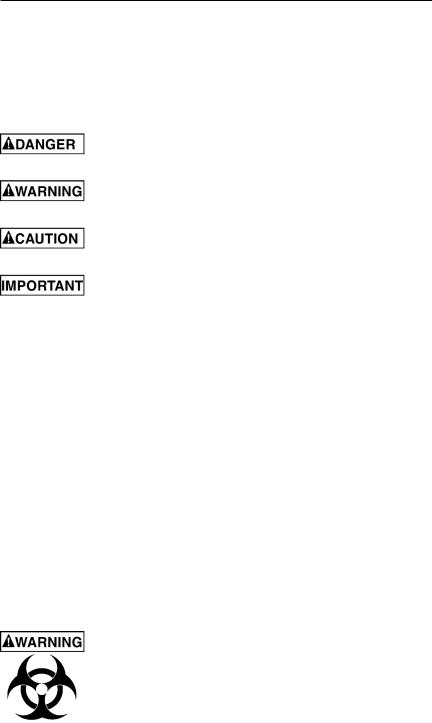
IMPORTANT: READ AND SAVE THIS SAFETY AND INSTRUCTION MANUAL.
SAVE THESE INSTRUCTIONS – The INC-4825A offers a wide range of features to accommodate your needs. This manual will show you how to use your charger safely and effectively. Please read, understand and
follow these instructions and precautions carefully, as this manual contains important safety and operating instructions. The safety messages used throughout this manual contain a signal word, a message and an icon.
The signal word indicates the level of the hazard in a situation.
Indicates an imminently hazardous situation which, if not avoided, will result in death or serious injury to the operator or bystanders.
Indicates a potentially hazardous situation which, if not avoided, could result in death or serious injury to the operator or bystanders.
Indicates a potentially hazardous situation which, if not avoided, could result in moderate or minor injury to the operator or bystanders.
Indicates a potentially hazardous situation which, if not avoided, could result in damage to the equipment or vehicle or property damage.
Safety messages in this manual contain two different type styles.
•Unnumbered type states the hazard.
•Numbered type states how to avoid the hazard.
The icon gives a graphical description of the potential hazard.
Pursuant to California Proposition 65, this product contains chemicals known to the State of California to cause cancer and birth defects or other reproductive harm.
• 1 •

1.IMPORTANT SAFETY INSTRUCTIONS
Risk of electric shock or fire.
1.1Do not expose the charger to rain or snow.
1.2Use only recommended attachments. Use of an attachment not recommended or sold by Schumacher® Electric Corporation may result in a risk of fire, electric shock or injury to persons or damage to property.
1.3To reduce the risk of damage to the electric plug or cord, pull by the plug rather than the cord when disconnecting the charger.
1.4An extension cord should not be used unless absolutely necessary. Use of an improper extension cord could result in a risk of fire and electric shock.
If an extension cord must be used, make sure:
•That the pins on the plug of the extension cord are the same number, size and shape as those of the plug on the charger.
•That the extension cord is properly wired and in good electrical condition.
•That the wire size is large enough for the AC ampere rating of the charger as specified in Section 7.
1.5To reduce the risk of electric shock, unplug the charger from the outlet before attempting any maintenance or cleaning. Simply turning off the controls will not reduce this risk.
1.6Remove personal metal items such as rings, bracelets, necklaces and watches when working with a lead-acid battery. A lead-acid battery can produce a short-circuit current high enough to weld a ring or the like to metal, causing a severe burn.
1.7Do not operate the charger with a damaged cord or plug; take it to a qualified service person. (Call customer service at: 1-800-621-5485.)
1.8Do not operate the charger if it has received a sharp blow, been dropped or otherwise damaged in any way; take it to a qualified service person. (Call customer service at: 1-800-621-5485.)
1.9Do not disassemble the charger; take it to a qualified service person when service or repair is required. Incorrect reassembly may result in a risk of fire or electric shock. (Call customer service at: 1-800-621-5485.)
• 2 •
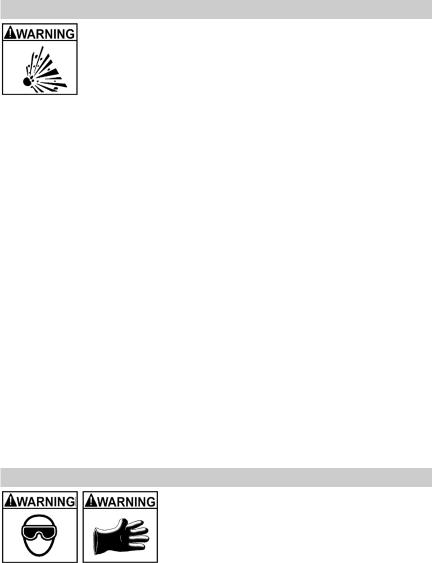
2.PERSONAL PRECAUTIONS
Risk of explosive gases.
2.1Working in the vicinity of a lead-acid battery is dangerous. Batteries generate explosive gases during normal battery operation. For this reason, it is of utmost importance that you follow the instructions each time you use the charger.
2.2To reduce the risk of a battery explosion, follow these instructions and those published by the battery manufacturer and the manufacturer of any equipment you intend to use in the vicinity of the battery. Review the cautionary markings on these products and on the engine.
2.3This charger employs parts, such as switches and circuit breakers, that tend to produce arcs and sparks. If used in a garage, locate this charger
18 inches or more above floor level.
2.4NEVER smoke or allow a spark or flame in the vicinity of a battery or engine.
2.5Be extra cautious to reduce the risk of dropping a metal tool onto the battery. It might spark or short-circuit the battery or other electrical part that may cause an explosion.
2.6Use this charger for charging LEAD-ACID batteries only. It is not intended to supply power to a low voltage electrical system other than in a startermotor application. Do not use this battery charger for charging dry-cell batteries that are commonly used with home appliances. These batteries may burst and cause injury to persons and damage to property.
2.7NEVER charge a frozen battery.
2.8NEVER overcharge a battery.
3.PREPARING TO CHARGE
Risk of contact with battery acid. Battery acid is a highly corrosive sulfuric acid.
3.1Consider having someone close enough by to come to your aid when you work near a lead-acid battery.
3.2Have plenty of fresh water and soap nearby in case battery acid contacts your skin, clothing or eyes.
3.3Wear complete eye and body protection, including safety goggles and protective clothing. Avoid touching your eyes while working near the battery.
3.4If battery acid contacts your skin or clothing, immediately wash the area with soap and water. If acid enters your eye, immediately flood the eye with cold running water for at least 10 minutes and get medical attention right away.
•3 •
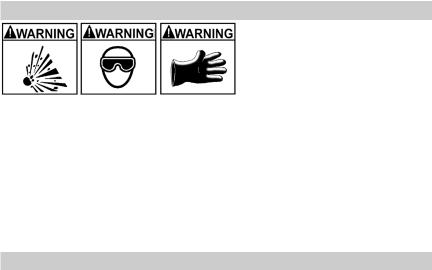
3.5If it is necessary to remove the battery from the vehicle to charge it, always remove the grounded terminal first. Make sure all of the accessories in the vehicle are off to prevent arcing.
3.6Be sure the area around the battery is well ventilated while the battery is being charged.
3.7Add distilled water to each cell until the battery acid reaches the level specified by the battery manufacturer. Do not overfill. For a battery without removable cell caps, such as valve regulated lead acid batteries (VRLA), carefully follow the manufacturer’s recharging instructions.
3.8Read, understand and follow all instructions for the charger, battery, vehicle and any equipment used near the battery and charger. Study all of the battery manufacturer’s specific precautions while charging and recommended rates of charge.
3.9Determine the voltage of the battery by referring to the vehicle owner’s manual and make sure that the output voltage is correct.
3.10Make sure that the charger cable connector makes tight connections.
4.CHARGER LOCATION
Risk of explosion and contact with battery acid.
4.1Locate the charger as far away from the battery as the DC cables permit.
4.2Never place the charger directly above the battery being charged; gases from the battery will corrode and damage the charger.
4.3Do not set the battery on top of the charger.
4.4Never allow battery acid to drip onto the charger when reading the electrolyte specific gravity or filling the battery.
4.5Do not operate the charger in a closed-in area or restrict the ventilation in any way.
5.DC CONNECTION PRECAUTIONS
5.1Connect and disconnect the DC output cables only after setting the charger switch to the “off” position and removing the AC plug from the electrical outlet.
• 4 •
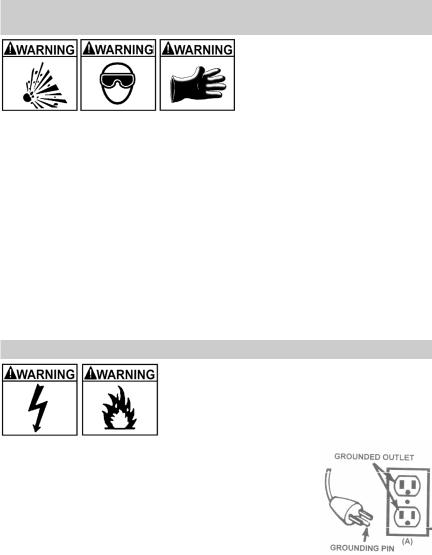
6.FOLLOW THESE precautions WHEN connecting the BATTERY.
A spark near the battery may cause a battery explosion. To reduce the risk of a spark near the battery:
6.1Position the AC and DC cables to reduce the risk of damage by the hood, door and moving or hot engine parts. NOTE: If it is necessary to close the hood during the charging process, ensure that the hood does not touch the metal part of the battery clips or cut the insulation of the cables.
6.2Stay clear of fan blades, belts, pulleys and other parts that can cause injury.
6.3When disconnecting the charger, turn the switch to off, disconnect the AC cord and then disconnect the charger from the battery.
6.4See CALCULATING CHARGE TIME for length of charge information.
6.5Do not face the battery when making the final connection.
6.6When disconnecting the charger, always do so in the reverse order of the connecting procedure and break the first connection while as far away from the battery as practical.
7.BATTERY CHARGING – AC CONNECTIONS
Risk of electric shock or fire.
7.1This battery charger is for use on a nominal 120-volt circuit and has a grounded plug that looks like the plug illustrated. The charger must be grounded to reduce the risk of electric shock. The plug must be plugged into an outlet that is properly installed and grounded in accordance with all local codes and ordinances. The plug pins must fit the receptacle (outlet). Do not use with an ungrounded system.
NOTE: The INC-4825A intermittently draws more than 15 amps of current. We recommend that you either install a 20 amp circuit or do not run anything else on the same circuit as the INC-4825A or you may trip the breaker supplying the AC power.
7.2Never alter the AC cord or plug provided – if it does not fit the outlet, have a proper grounded outlet installed by a qualified electrician. An improper connection can result in a risk of an electric shock or electrocution.
NOTE: The use of an adapter plug is not recommended.
•5 •
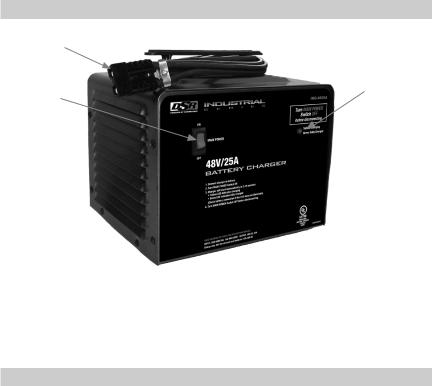
7.3Recommended minimum AWG size for extension cord:
•25 feet long or less - use a 12 gauge extension cord.
•25 feet to 50 feet long - use a 10 gauge extension cord.
•Over 50 feet long - not recommended.
8. FEATURES
3
1 |
2 |
|
1.ON/OFF Switch
2.Charging/Charged LED
3.Quick-Connect Connector
9.OPERATING INSTRUCTIONS
Automatic Temperature Compensation
The charger adjusts the maximum charge voltage and maximum maintain voltage based on the ambient air temperature. This permits optimum charging and safety.
Thermal Runaway
The charger automatically reduces the current if it detects the battery may be getting too hot. This is a safety precaution.
Charging
1.Ensure that all of the charger components are in place and in good working condition.
2.Connect the battery to the charger by connecting the quick-connect connector on the charger output cable to the quick-connect connector on the battery.
3.Connect the AC power following the precautions listed in Section 7.
4.Switch the power switch to the ON position to turn the charger on.
•6 •
Automatic Charging Mode
When an Automatic Charge is performed, the charger switches to the
Maintain Mode (see below) automatically after the battery is charged.
Aborted Charge
If charging can not be completed normally, charging will abort. When charging aborts, the charger’s output is shut off, and the CHARGING
(yellow) LED will blink. To reset after an aborted charge, either disconnect the battery or turn off the charger.
Desulfation Mode
If the battery is left discharged for an extended period of time, it could become sulfated and not accept a normal charge. If the charger detects a sulfated battery, the charger will switch to a special mode of operation designed for such batteries. If successful, normal charging will resume after the battery is desulfated. Desulfation could take 8 to 10 hours. If desulfation fails, charging will abort and the CHARGING (yellow) LED will blink.
Completion of Charge
Charge completion is indicated by the CHARGED (green) LED. When lit, the charger has switched to the Maintain Mode of operation.
Maintain Mode (Float-Mode Monitoring)
When the CHARGED (green) LED is lit, the charger has started Maintain
Mode. In this mode, the charger keeps the battery fully charged by delivering a small current when necessary. If the battery voltage drops below a preset level, the charger will go back into Charge Mode until the battery voltage returns to the full charge level, at which point the charger will return to Maintain Mode.
NOTE: The charger automatically switches between Charge Mode and
Maintain Mode as necessary. The CHARGED (green) LED will cycle on when the battery is at full charge and off when the voltage drops below a preset level and the charger goes into Charge Mode. This cycle will continue, and the CHARGED (green) LED will stay on for longer periods of time as the battery becomes more fully charged.
Power Saving Mode
The charger has an internal relay that switches the power transformer on and off automatically. This means, that the charger uses very little power when in standby mode or maintain mode.
General Charging Notes
Fan: The charger is designed to control its cooling fan for efficient operation. Consequentially, it is normal for the fan to start and stop when maintaining a fully charged battery. Keep the area near the charger clear of obstructions to allow the fan to operate efficiently.
• 7 •

10.CALCULATING CHARGE TIME
The Hydrometer or Electronic Method
To find the time needed to fully charge your battery, determine the battery’s charge level with a hydrometer or electronic Percent-of-Charge Tester. The following table will help you convert hydrometer readings to percent of charge values.
SPECIFIC GRAVITY |
PERCENT OF CHARGE |
PERCENT OF CHARGE |
|
|
NEEDED |
1.265 |
100% |
0% |
1.225 |
75% |
25% |
1.155 |
25% |
75% |
1.120 |
0% |
100% |
When you know the percent of charge and the Amp Hour (AH) rating of your battery, you can calculate the approximate time needed to bring your battery to a full charge.
To convert Reserve Capacity to Amp Hours, divide Reserve Capacity by 2, and add 16:
Example:
Amp Hour Rating = Reserve Capacity + 16 2
NOTE: The Reserve Capacity can be obtained from the battery specification sheet or the owner’s manual.
To calculate the time needed for a charge:
1.Find the percent of charge needed. (A battery at 50 percent charge that will be charged to 100 percent needs another 50 percent (.50)).
2.Multiply the Amp Hour Rating by the charge needed (.50) and divide by the charger setting (17 amps average).
3.Multiply the results by 1.25 and you will have the total time needed, in hours, to bring the battery to full charge.
4.Add an additional hour for a deep-cycle battery.
Example:
Amp Hour Rating x % of charge needed x 1.25 = hours of charge Charger Setting
100 (AH Rating) x .50 (charge needed) x 1.25 = 3.676 hours 17 (Charger Setting)
100 x .50 x 1.25 = 3.676
17
You would need to charge your 100-Ampere Hour Battery for a little more than 3 hours using the above example.
• 8 •
